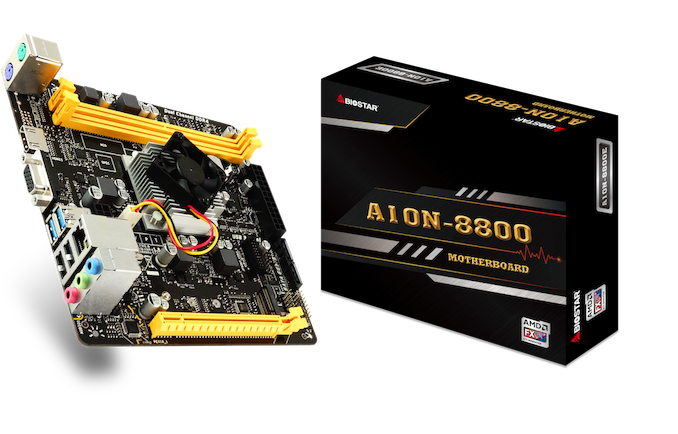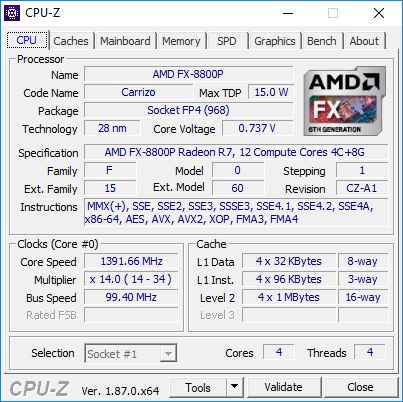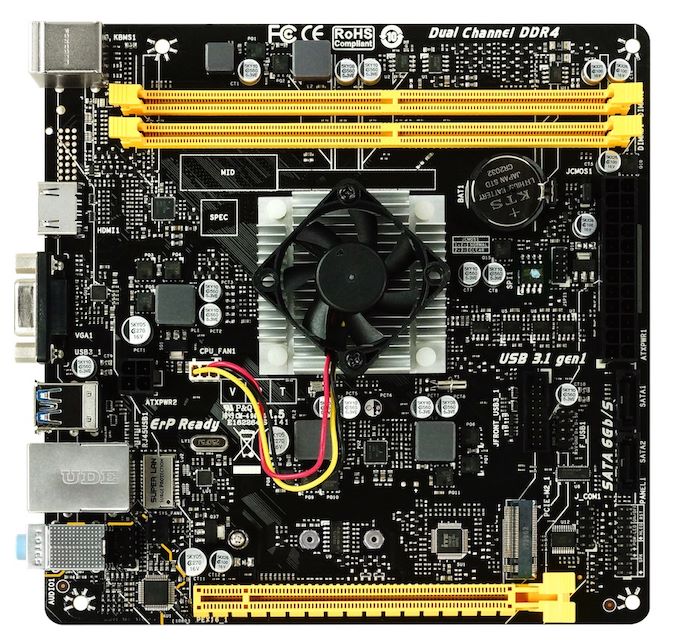The Biostar A10N-8800E Motherboard Review: Carrizo in 2019?!
by Dr. Ian Cutress & Gavin Bonshor on August 14, 2019 8:00 AM EST- Posted in
- Motherboards
- CPUs
- AMD
- Biostar
- Mini ITX
- HTPC
- Carrizo
- A10N-8800E
- FX-8800P
- Athlon 200GE

The Biostar A10N-8800 motherboard is a mini-ITX SoC option with an integrated AMD FX-8800P processor. Also featured is support for up to 32 GB of DDR4-2133 memory, a single full-length PCIe 3.0 x16 slot, and a Realtek RTL8111H Gigabit Ethernet port. The AMD FX-8800P is traditionally a mobile SKU with a TDP of 35 W and Biostar integrates into a small form factor package for desktop users with four CPU cores and eight Radeon R7 graphics cores.
We asked for a review sample of this motherboard for the simple reason that we did not expect to see a brand new AMD Carrizo based design hit the market in 2019. Carrizo is from AMD's older family of processors, pre-Zen, and Biostar believes there is a new market out there for mobile-class gaming machines. The FX-8800E processor being used here sits at the top of Biostar's stack of integrated CPU offerings, which makes it even more bizarre that there are lower powered chips available for this sort of thing. We still wanted to give it our traditional motherboard rundown.
Biostar A10N-8800E Overview
The Biostar A10N-8800E mini-ITX motherboard comes pre-installed with AMD’s FX-8800P Carrizo based SoC processor which utilizes four cores, four threads, with a maximum core clock speed of up to 3.4 GHz. The AMD FX-8800P is the top tier processor from the 6th generation Carrizo family with '12 compute cores' according to the marketing materials: four for the CPU and eight for the Radeon R7 integrated graphics module. With a lot of SoC offerings, low power consumption is a huge factor and the SoC is rated for a 15 W TDP, with OEM configuability up to 35W.
While not benefiting from the kind of grunt power that a processor containing AMD Zen architecture offers, the FX-8800P represents a more modest option and has built-in hardware HEVC and H.265 decoding abilities. That being said, the FX-8800P is using AMD's outdated Excavator architecture, which isn't detrimental as such, but it slots it into a lower positioned tier of products.
Looking at the Biostar A10N-8800E as we do with all motherboards, the board has an all-black PCB with a set of yellow contrasting slots; Biostar could have even gone with the Bumblebee to generate some BUZZ. In the center of the board is the very basic and low profile integrated CPU heatsink, with a basic 2+1 phase power delivery (two for the CPU and one for the iGPU/SoC). Located at the top of the board and mounted horizontally, is two RAM slots with support for DDR4-2133 and up to a maximum capacity of 32 GB. At the bottom is a single full-length PCIe 3.0 x16 slot with a single M.2 slot situated directly above it; a total of two SATA connectors makes up the rest of the onboard storage capabilities.
The rear panel of the Biostar A10N-8800E represents simplicity connectors with just four USB connectors on the rear panel, all Type-A with two USB 3.1 G1 and two USB 2.0. Legacy users will appreciate a separate PS/2 keyboard and mouse port, with an HDMI and D-sub pairing of video outputs. A basic Realtek ALC887 HD audio codec takes care of the onboard audio, while a Realtek RTL8111H Gigabit NIC powers the single Ethernet port.
When it comes to the system performance of the Biostar A10N-8800E, there are certainly some positive points to go away with when benchmarked on our test bed. Booting into Windows 10 64 bit from our Crucial MX300 1 TB test bed SSD, we achieved a very respectable result of 18.6 seconds at default. When stripped of the networking and audio controllers, we managed to shave around an extra second off that time. Power consumption as expected is also favorable with a maximum peak load in our stress testing of just 53.8 W. This was tested without a discrete graphics card as the main focus is on the capability of the integrated AMD FX-8800P processor.
Marketed as an 'Edge Computing' solution, the Biostar A10N-8800E uses a mini-ITX PCB and a mobile processor. With a TDP of just 15 W, it opines to be a low powered desktop system or even a microserver. The motherboard itself has plenty to shout about with a Realtek pairing of networking and onboard solutions which aren't high-end but are more than up to the task, and with integrated Radeon R7 graphics with HDCP support, it could be the perfect foundation for a solid small form factored HTPC.













73 Comments
View All Comments
hojnikb - Friday, August 16, 2019 - link
I bet there must be a ton of leftover chips, that amd is selling for peanuts.DominionSeraph - Saturday, August 17, 2019 - link
Now compare it to an i5 2400 system you can get off ebay for $90.Haawser - Monday, August 19, 2019 - link
Yeah, but you can't put that in a 1.5L mini-itx box with a pico-PSU and make a tiny little PC can you ? It's the low watts and low cooler height that make these type of boards so attractive.John_M - Saturday, September 14, 2019 - link
It's also available new, unlike the i5 2400 from ebay.skomo - Sunday, August 18, 2019 - link
I love this kind of "things".Will this "combo" ideal to run various emulators? Psx, ps2, Dolphin (NGC/WII)?
I'd love one under my TV.
versesuvius - Sunday, August 18, 2019 - link
They probably made this motherboard 3 years ago but forgot to sell it.RuthLMartinez - Monday, August 19, 2019 - link
hypraeses - Monday, August 19, 2019 - link
I bought one of these a little while ago as it seemed to fit with a bunch of leftover parts collected over the years and wanted to play with it for comparison as a living room PC. It seems okay, but perhaps not the best value. The biggest flaw I had at least with the personal unit I had was it would regularly thermal throttle (95C) even with the fan profile on aggressive or manual full. Sitting at the BIOS alone for an hour seemed to be too much for it. I tried different thermal paste, new springs/pins, screws etc for mounting and eventually tried different heatsinks. It seems in general this one is relatively poor. I ended up taking an drill and angle grinder to an old stock Socket AM2/AM3 heatsink to make clearances and went with that. I used nail polish on the surface mount components around the die, then covered it in thermal paste as well as the die then epoxied the heatsink down (as my drill/tapping skills weren't up to the task). It seems to peak at 49C now and maintain full clocks.What I want know, how is anyone else's thermals with these boards? I would personally go with the 320GE if I had a do-over purely because of the annoyances of cooling.
pc start - Friday, August 23, 2019 - link
eu particularmente não gosto de cpu integrada.lwatcdr - Saturday, August 31, 2019 - link
I want to know why the author used the word two and not the number 2 in the chart for the quantity of SATA ports on the board? It is just really inconsistent and frankly annoying. If the reason is that is how the manufacture did it and they just cut and pasted it, shame on you.